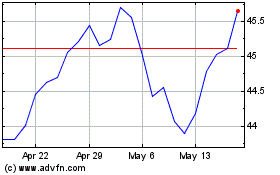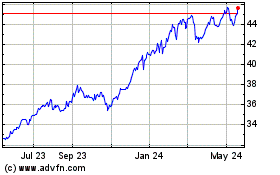Indian economy appears to have turned the corner. Recent HSBC
survey--which maps manufacturing and services sectors—showed
that India expanded at a faster rate than China during the month of
February. (Read: 3 Red Hot Dividend ETFs)
Further, trade data for the month of February showed that the
exports rose for the second month in a row, pushing the trade
deficit to its lowest level in 10 months. Better trade data
resulting from pickup in exports to Europe, is likely to result in
an improvement in current account deficit this year.
The budget presented by the Indian government recently had many
investor and business friendly measures—which could put the economy
back on the higher growth path, even though the budget did not do
much to alleviate concerns regarding widening fiscal and current
account deficits.
As the inflation seems to be coming under control, there are
hopes for another rate cut by the central bank (after a cut in
January this year), which would further support growth.
According the government, the economy will grow between
6.1% and 6.7% in the fiscal year starting April 1, after an
estimated 5.5% growth for the current year—its slowest growth rate
in a decade. A recent report by the Moody’s projects the economy to
grow at ~7% from 2014 onwards.
As a result of the recent optimism, the stock market is at its
highest level in about two years and the currency has been
strengthening. (Read: Buy these ETFs for higher returns and lower
risk)
Earlier last year, S&P and Fitch had downgraded the outlook
on the country and warned of a sovereign credit downgrade. If
downgraded, India would be the first country in the BRICs block to
lose its investment grade rating.
It appears that the downgrade threats were a wake-up call for
the Indian policy makers. Later last year, the government announced
many significant reforms. While the reforms were a welcome change
after many years of policy paralysis in the country since they
indicated the government’s willingness to take political risks even
in the face of looming elections, it is important that the reforms
are implemented at the earliest.
Further, even with the recent optimism, it is quite unlikely
that the economic growth will revert to 8-9% growth recorded during
2004-2011 anytime soon. India suffers from some structural problems
like high fiscal deficit, massive corruption, chronic inflation and
very bad infrastructure.
Indian stock market exhibits high volatility since its
performance is largely driven by foreign institutional inflows. The
currency also remains vulnerable to major capital flows, even
though the country has foreign exchange reserves of approximately
$300 billion, as the currency market is much less liquid than major
currency markets. (Read: 3 Excellent ETFs for Income Investors)
At the same time, despite several constraints, the growth in
India is still one of the highest in the world. Positive factors
like a rising middle class and a younger population with growing
spending power which results in soaring domestic consumption will
continue to fuel growth.
For investors seeking broad exposure to Indian equities,
following ETF choices are available:
Wisdom Tree India Earning Fund (EPI)
EPI is the most popular ETF in this space, with about $1.1
billion in AUM. It tracks the Wisdom Tree India Earning Index,
which weights the Indian companies based on their earnings. It
charges the investors 83 basis points for annual expenses.
In terms of sector weightings, the fund has highest exposure to
financials (26%), followed by energy (21%), information technology
(14%) and materials (10%).Top 10 holdings account for more than 40%
of total holdings. EPI is currently Zacks #1 Rank (Strong Buy)
ETF.
PowerShares India Portfolio (PIN)
PIN which tracks the Indus India Index, has assigned highest
weighting to the Energy sector (26%), followed by information
technology (19%) and financials (18%).
The expense ratio of the ETF is 81 basis points. Top ten
holdings constitute 58% of the holdings. PIN is currently
Zacks #2 Rank (Strong Buy) ETF.
S&P India Nifty 50 Index
Fund (INDY)
INDY follows S&P CNX Nifty Index, a free float market cap
weighted index of 50 largest and most liquid Indian companies. It
charges the investors 92 basis points for annual expenses.
Top 10 companies in the fund account for 59% of the fund. Sector
weighting are: financials (28%), Information Technology (14%) and
power (13%). INDY is currently Zacks #1 Rank (Strong Buy) ETF.
iShares MSCI India Index Fund (INDA)
This is the newest ETF in the space, launched in February last
year. The fund follows MSCI India Index, which is float adjusted
market cap weighted index. With the expense ratio at 0.67%, this is
the cheapest option now.
Financials enjoy highest weighting (31%), followed by
information technology (17%) and energy (12%). Top ten companies
account for more than half of the total holdings. INDA is currently
Zacks #2 Rank (Strong Buy) ETF.
Want the latest recommendations from Zacks Investment Research?
Today, you can download7
Best Stocks for the Next 30 Days.Click
to get this free report >>
WISDMTR-IN EARN (EPI): ETF Research Reports
ISHARS-M INDIA (INDA): ETF Research Reports
ISHARS-SP INDIA (INDY): ETF Research Reports
PWRSH-INDIA POR (PIN): ETF Research Reports
To read this article on Zacks.com click here.
Zacks Investment Research
Want the latest recommendations from Zacks Investment Research?
Today, you can download 7 Best Stocks for the Next 30 Days. Click
to get this free report
WisdomTree India Earnings (AMEX:EPI)
Historical Stock Chart
From Mar 2024 to Apr 2024

WisdomTree India Earnings (AMEX:EPI)
Historical Stock Chart
From Apr 2023 to Apr 2024
